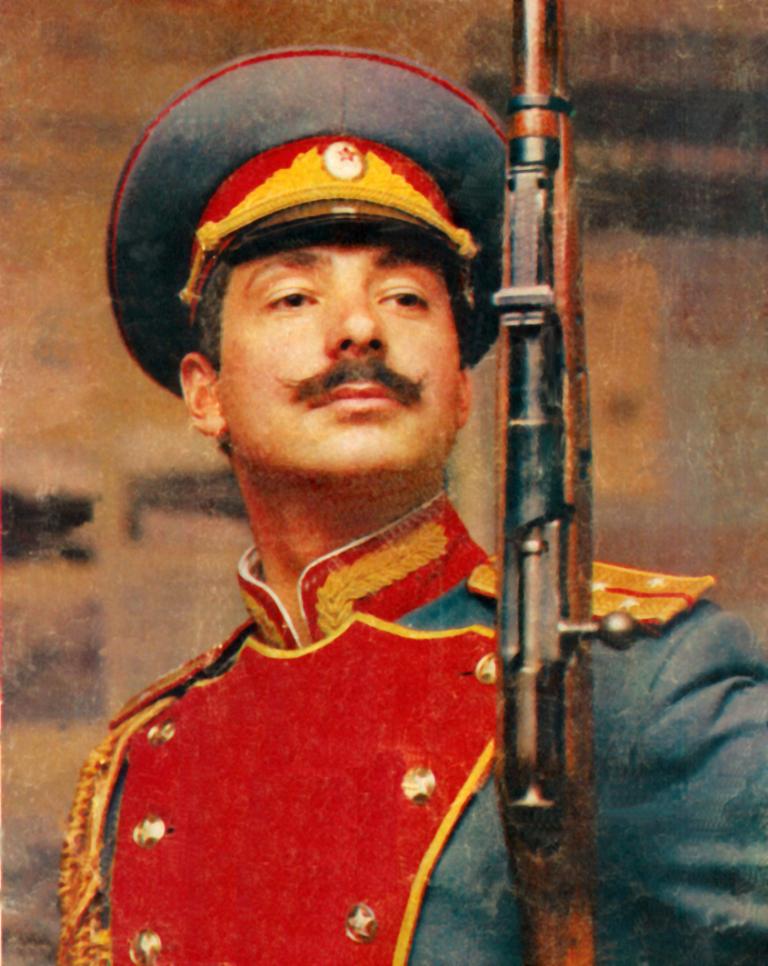 Caps of Soviet Honor Guards and Orchestras
Caps of Soviet Honor Guards and OrchestrasIntroduction
This page describes caps and, to some extent, the uniforms worn by members of the Honor Guards and Orchestras of the Soviet Army, Air Force and Navy.
A thumbnail image accompanies each cap description. Clicking on that thumbnail will bring up a larger, higher resolution image.
Honor Guards
Virtually all large military units could (and did) form honor guards on an ad-hoc or "extra duty" basis to represent their units in parades and ceremonies such as change of commands and recruit oaths of allegiance and while performing guard at the unit's places of honor. Most of the time, unit honor guards wore standard military dress uniforms according to their rank and service. You can see examples of these dress uniforms on my service-specific pages on the Cap Museum listing to the left. However, the caps on this page represent the next step up from these groups - those specifically established as full-time honor guards presenting the Ministry of Defense and headquarters of selected military garrisons and Groups of Forces. These latter honor guards had specialized and striking uniforms designed to impress foreign dignitaries and evoke pride within the Soviet and allied citizenry observing state ceremonies.
The 1st Separate Honor Guard Company assigned to the Moscow military garrison was the most visible and well-known of Soviet military honor guards. As the most "senior" honor guard unit within the Ministry of Defense, they were routinely tasked to accord honors to visiting foreign dignitaries at state ceremonies in Moscow and to perform guard mounts at various ceremonies including anniversary parades on Red Square, state funerals and, late in the Soviet era, at the Eternal Flame of the Tomb of the Unknown Soldier (interestingly, for most of the Cold War period the tomb was unguarded except during special occasions). This company originated back in 1944 with the creation of the NKVD "Dzerzhinsky" division; subsequently becoming the 465th Separate Rifle Company in 1948. After at least one more reorganization/redesignation, it became the 1st Separate Honor Guard Company in 1956 and was subordinated directly to the Moscow Garrison Commandant. The Military Orchestra of the Honor Guard was also subordinated to the Moscow Commandant at this time. An all-Army honor guard at first, the 1st Company incorporated Air Force and Navy platoons in 1960. The Honor Guard Company was later absorbed into the 154th Separate Commandant's Regiment when it was formed in 1979 on the basis of an existing Moscow garrison's separate battalion and the Honor Guard. It retained this organization through the collapse of the USSR.
In the immediate Post-War period, the Moscow garrison Honor Guard Company wore standard parade NKVD uniforms, including the blue-topped caps shown on my MVD/NKVD/NKGB/MGB page.
This changed in 1955 when company personnel were authorized special steel-colored uniforms roughly modeled on the new officer dress "Zhukov" uniforms but with additional gilt embroidery and red distinctions.
The large gold-edged red chest plastron was this uniform's most striking feature.
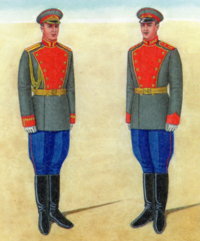 All members of the Honor Guard wore matching steel gray visor caps with red band and piping (red bands were only used on Honor Guard and generals' caps during this period; rifle/motorized rifle troops wore crimson up to 1969).
By the mid-1960s this uniform (sometimes with minor variations) was also in general use within honor guard companies formed in the Groups of Forces and selected military garrisons within the USSR.
All members of the Honor Guard wore matching steel gray visor caps with red band and piping (red bands were only used on Honor Guard and generals' caps during this period; rifle/motorized rifle troops wore crimson up to 1969).
By the mid-1960s this uniform (sometimes with minor variations) was also in general use within honor guard companies formed in the Groups of Forces and selected military garrisons within the USSR.
A major change took place in the makeup of the Moscow garrison's 1st Separate Honor Guard Company in 1960, when platoons of the other services were incorporated - VVS (Air Force) and VMF (Navy).
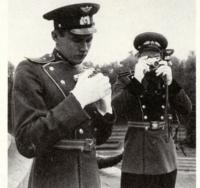 While the Navy platoon just wore a slightly modified Naval uniform, Air Force personnel adopted a uniform quite similar to that of the Army honor guard uniform
but with light blue (azure) cloth replacing the Army red; including on the plastron.
Other changes included air force shoulderboard symbols and, on the cap, metal wings pinned to the crown and a two-piece air force M55 cockade on the band.
You can see such a uniform in the black and white picture shown to the right taken at the Soviet War Memorial at Treptower Park, East Berlin.
While the Navy platoon just wore a slightly modified Naval uniform, Air Force personnel adopted a uniform quite similar to that of the Army honor guard uniform
but with light blue (azure) cloth replacing the Army red; including on the plastron.
Other changes included air force shoulderboard symbols and, on the cap, metal wings pinned to the crown and a two-piece air force M55 cockade on the band.
You can see such a uniform in the black and white picture shown to the right taken at the Soviet War Memorial at Treptower Park, East Berlin.
An interesting variation to the M-1955 Army Honor Guard uniform has also been documented within the Honor Guard Company of the GSFG Headquarters.
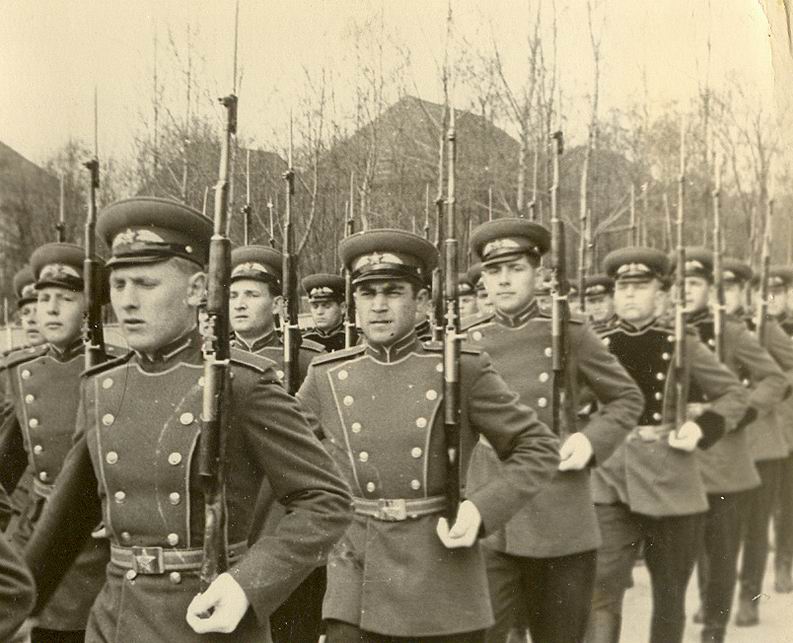 As you can see in this photograph to the left taken during a parade in 1965 in Wunsdorf; both red and black distinctions (including plastrons and cap bands) were being worn simultaneously, presumably to signify the importance of tank troops to the GSFG's mission.
However, it appears this was a short-lived GSFG-only initiative, since no regulations have been found describing this uniform nor did it apparently expand into other military districts or Groups of Forces.
As you can see in this photograph to the left taken during a parade in 1965 in Wunsdorf; both red and black distinctions (including plastrons and cap bands) were being worn simultaneously, presumably to signify the importance of tank troops to the GSFG's mission.
However, it appears this was a short-lived GSFG-only initiative, since no regulations have been found describing this uniform nor did it apparently expand into other military districts or Groups of Forces.
Photographs show evolving insignia wear patterns on the Army M-1955 uniform over the years, with the most commonplace being the replacement of the soldiers' cap band red stars with the M-55 officer's oval cockade.
M-1971 uniforms
In 1971, in the wake of the 1969/70 regulations which changed virtually all military uniforms, the 1st Separate Honor Guard Company and the Model Orchestra of the Honor Guard were also authorized a more "modern" style uniform; although this took a few years to fully implement. Regulations later extended the right to wear these special uniforms to honor guard units at Groups of Forces' and selected military garrisons. These new uniforms were similar to those of the general Army, Air Force and Navy; although with specialized ornaments and aspects of officer uniforms incorporated into soldier uniforms.
Army (Ground Forces) Platoon
Officers assigned to the Army platoon of the 1st Company wore wave-green parade uniforms while rank and file wore khaki. Honor Guard officers differed from their line unit counterparts in that they wore gold aiguillettes, special breast badges, special sleeve insignia and cuff embroidery and, on their caps - gold metal visor ornaments and the special Honor Guard "sunburst" introduced in 1971, either pinned or sewn to the crown. Uniforms of soldiers and sergeants differed from regular rank & file parade uniforms in that they included shoulderboards edged in gold lace and included silver aiguillettes, embroidered sleeve patches, gold edged collar tabs and, on their caps - gold cords and the special Honor Guard "sunburst".
Air Force Platoon
Like their Army counterparts, Air Force Honor Guard officers and rank and file wore uniforms based on standard service parade uniforms with the added elements mentioned above. However, the rank and file tunic - although patterned like the Army's khaki version - was instead sewn from the same dark blue cloth as Air Force officers. Since the Air Force already had a cap crown badge (wings) - this was worn instead of the Army "sunburst." Only the added gilt metal visor leaves set the Honor Guard officers' cap apart from the standard officer parade cap. Honor Guard sergeants and soldiers wore officer parade caps but with the soldiers' parade star & wreath emblem.
Navy Platoon
Navy officers attached to the Honor Guard Company also wore uniforms differing little from their regular component counterparts, except again for the aiguillettes and some gilt embroidery replacing stamped metal insignia. The rank and file, however, wore a special jacketed uniform unique to Honor Guards, gold-edged "Ф" shoulderboards and special sleeve insignia. Caps were identical with those of Fleet personnel, including both white (summer) and black (winter) versions. Officers wore the same gilt metal visor leaves as officers in the other platoons, which were standard Navy parade wear during this period. Rank and file sailors wore the beskozirka marked with a ВОЕННО-МОРСКОЙ ФЛОТ tally and the standard parade star & wreath on the crown. Of note: they did NOT wear orange and black striped Guards tapes since none of these units had ever been so designated, in spite of their ceremonial role.
Army Honor Guard
NCO/Soldier Parade
1955-1970
As discussed above, just prior to the official formation of the 1st Separate Honor Guard Company, a new (and unique) steel-gray uniform was introduced for its members in 1955.
This 1955-dated cap was one of the first thus produced and illustrates all the "high-end" elements originally mandated in the associated regulations.
The napped wool crown was in the same shade of gray as that introduced for officers dress uniforms in 1955 - the so-called "Zhukov" model which I discuss on my Army pages.
Both band and piping are red; a combination only assigned to honor guards and generals at the time. The style and shape of the cap also mirror that of the Zhukov model.
The visor is black painted fiberboard and the chinstrap is black oilcloth. It is held in place by two standard Soviet Army buttons. The most striking feature is, of course,
the band emblem. This consists of two parts: two embroidered elongated stylized oak leaves surrounding a red enamel star outlined in bullion. Both elements
were sewn directly onto the band material, which was then sewn together to the other cap elements - giving a very clean appearance. All the embroidery is in gilt wire, in two different styles.
The red star is removable. An all-metal removable emblem also existed and is discussed below.
Very Rare
| When originally authorized, the gilt insignia on rank and file caps was to be embroidered, as you can see on my cap above and in the close-up below to the left. However, photographs indicate that such embroidery was not standard, with many - if not most - honor guard units outside Moscow utilizing the stamped metal version shown below to the right. This was almost certainly a cost issue, with gilded wire embroidery very expensive and difficult to repair if damage. |

|
Army Honor Guard
Officer Parade
1971-1991
Shown here is a 1987-dated officer's cap reflecting the 1971 Honor Guard addendum to the 1970 uniform regulations.
It is a standard Motorized Rifle officer's wave green-and-red parade cap with the addition of gilt metal leaves pinned through the visor and the special "sunburst" emblem on the crown.
While initial regulations for the 1st Company called for both the cockade and the sunburst to be embroidered, aluminum emblems became the norm later and were likely the only ones available outside Moscow.
The embroidered sunburst shown on this cap is made of gilded wire, surrounding a red felt shield and a gilt aluminum Great Seal of the USSR.
An elastic cord was often attached to the cord buttons to help secure the cap on the head during parades.
Very Rare with embroidered emblem; Scarce otherwise
Army Honor Guard
Conscript Parade
1971-1991
This is the other ranks' counterpart to the cap just discussed. Only the presence of officer-style cords and a gilt aluminum "sunburst" on the crown differentiates it from
khaki-and-red parade caps worn by Motorized Rifle conscripts (even Honor Guard rank and file personnel were conscripts; albeit specially chosen for their appearance
and demeanor). This 1985-dated cap is one of the very last sewn with a fiberboard visor. I have only ever seen one-piece stamped sunburst emblems, although it's possible
two piece versions existed when first produced.
Available
Air Force Honor Guard
Officer Parade
1971-1991
The layout of this cap differs little from parade uniforms worn by all Air Force (and Airborne) officers during this period.
The crown was dark blue cotton, with band and piping in azure blue. Officer's gilt wings and the larger parade cockade & wreath badge were pinned through the crown and band respectively. As with the Army cap discussed above, officers were originally authorized
embroidered wings and cockade, but these have not been conclusively documented in use.
Only the addition of two stamped aluminum leaves pinned through the visor identifies this cap as one worn by Air Force Honor Guard officers.
Available-Rare (Although original AF Honor Guard caps are rare; addition of metal "leaves" to the visor of a common Air Force officer parade cap would result in an identical cap at a fraction of the cost!)
Air Force Honor Guard
Conscript Parade
1971-1991
Introduced at the same time as the new Army Honor Guard uniform in 1971, this cap was issued to conscript sergeants and soldiers of the Air Force platoon of the 1st Honor Guard Company.
In contrast to the Army platoon, where conscripts wore khaki caps, Air Force honor guards wore the same dark blue parade cap as their officers; to include
the crown "wings" and the officers' gilt filigree cords. Only the lack of visor leaves and use of the rank and file parade cockade (wreathed star)
differentiates this cap from a unit officer's.
Available (if assembled from officers' parade cap and soldier's star & wreath cockade)
Navy Honor Guard
Officer Parade
1971-1991
Officers assigned to the Navy platoon of the 1st Company (and to the various Fleet-level honor guards) wore standard Navy parade caps - either in black for winter or with a white cover for summer wear.
Once again, the cockade was originally prescribed as to be embroidered, but most photographs I have seen show the officers wearing the gilt aluminum cockade. Stamped aluminum leaves were pinned through the visor and
gilt cords were worn. Additional information on these caps can be seen on my Navy page.
Available
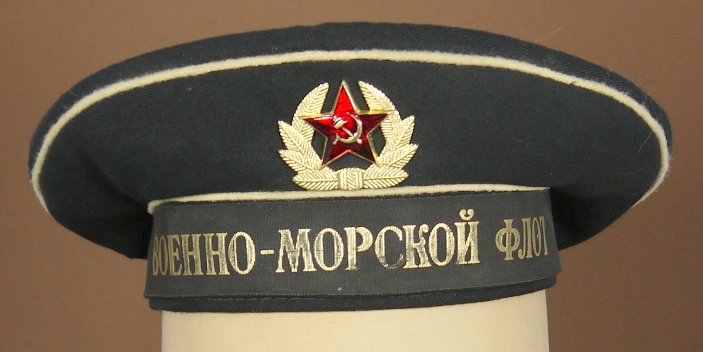 Navy Honor Guard
Navy Honor Guard
Conscript Parade
1971-1991
Like that of the officers, conscripts assigned to the Navy Honor Guard Platoon wore the standard parade cap for their rank: the visorless beskozirka, in either black or white.
The wreathed star parade emblem introduced in 1969 is pinned to the crown, since the band is covered with a black ribbon (or tally) stamped with ВОЕННО-МОРСКОЙ ФЛОТ in gold letters.
Honor guards assigned to the various fleets would have worn their own fleet tallies. Additional information on these caps can be seen on my Navy Beskozirka page.
Common
General Staff Guards
General Staff Guard Force
Extended Servicemen Duty
1971-19??
A little known fact is that the Soviet General Staff Headquarters (located just off Red Square in Moscow), had a uniquely-uniformed guard force manned by members of the Moscow Garrison. Two different, slightly varying uniforms were authorized by Ministry of Defense Order #59 in 1971. Extended servicemen (usually NCOs) assigned to this force wore a khaki service uniform but with a mix of elements associated both with officer and conscript parade uniforms. Red distinctions of the Motorized Rifle Troops were standard. Parade elements worn with the uniform included red piping down the outside seam of the breeches, gold-edged collar tabs, extended service-style shoulderboards and length of service stripes, and the cap shown here. This cap is very similar to that of the Army platoon of the 1st Honor Guard Company (with the gilt cords and sunburst emblem on the crown) but has the M-1969 officer's parade cockade on the band. This was the only occasion in which this emblem was worn on a non-parade cap. Boots and a white Sam Brown belt and holster completed the uniform. While discussed in the authoritative Russian-language book "Uniforms of the Armed Forces of the USSR and Russia 1917-1990;" Moscow, 1999; there has been no information as to when or if this uniform was abolished. The lack of information on this uniform can be explained by the fact it was for special duty only in the General Staff Headquarters, and was reportedly unit - not individual - property.
According to the same source, conscript personnel assigned to this guard force wore standard khaki Motorized Rifle rank and file parade uniforms but with Honor Guard-style caps (with sunburst and wreathed star emblems). They too, wore boots
and white officer style Sam Brown belts while on duty.
Available (from assembled elements)
Military Orchestras
The "Model Military Orchestra of the Honor Guard" was the premier Ministry of Defense military band. Stationed in Moscow/Lefortovo, its main duty was the accompaniment of the Separate Honor Guard Company in honoring visiting senior foreign government and military delegations and in providing music at social-political events of national importance (including major parades). The Model Orchestra was officially formed in 1956 on the basis of two existing MVD orchestras and subordinated to the Moscow Military Commandant.
Immediately prior to its official formation, soldiers of the Model Military Orchestra (and its counterparts in the Groups of Forces and selected Soviet-based military garrisons)
were authorized a special uniform.
This uniform was similar in many respects to that worn by Honor Guard troops of the period, but the base tunic and cap color was khaki vice steel-gray.
The primary distinguishing color was also red, but piping was dark blue. This photograph shows some bandsmen in this unique and very hard-to-find uniform.
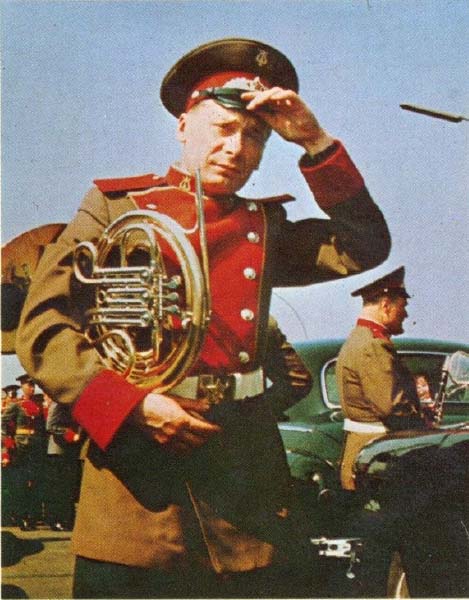 In addition to the lyre emblem on the crown, personnel of the Orchestra wore three different cockades on their cap bands during the period 1956 to 1970.
an enameled red star, an enameled red star surrounded by the 1950s honor guard-style embroidered wreath, or the M-1955 officer's cockade.
Shown to the right is probably the last variation of the M-1956 orchestra uniform worn in East Berlin, with officers' cockades replacing the red star with wreaths (and decorations now allowed to be pinned to the plastron!).
In addition to the lyre emblem on the crown, personnel of the Orchestra wore three different cockades on their cap bands during the period 1956 to 1970.
an enameled red star, an enameled red star surrounded by the 1950s honor guard-style embroidered wreath, or the M-1955 officer's cockade.
Shown to the right is probably the last variation of the M-1956 orchestra uniform worn in East Berlin, with officers' cockades replacing the red star with wreaths (and decorations now allowed to be pinned to the plastron!).
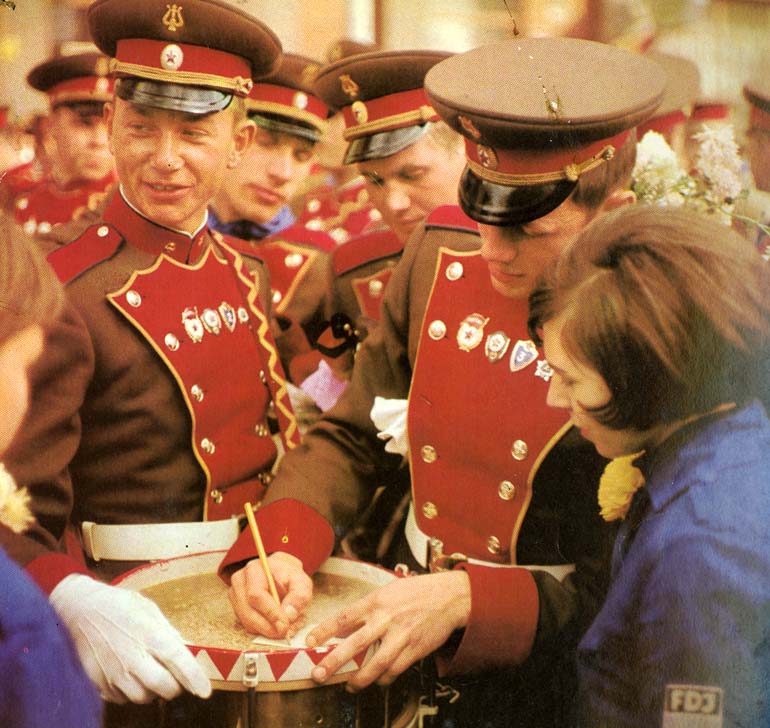 Photographs show officers of the orchestra wearing gray and red honor guard-style uniforms, in contrast to the khaki and red/blue of their soldiers.
Photographs show officers of the orchestra wearing gray and red honor guard-style uniforms, in contrast to the khaki and red/blue of their soldiers.
After 1970, the Military Orchestra of the Honor Guard and other selected Army orchestras (belonging to hero-cities garrisons and the like) wore the new khaki Army Honor Guard uniform described above, with the addition of a lyre symbol to the cap.
Of course many other Soviet military bands/orchestras existed; with virtually every division size element and larger having its own band. Most of these bands wore standard service uniforms; sometimes, but not always, with the addition of the lyre cap emblem.
Another similar organization worth highlighting that has received some exposure to Western audiences, was the Central (or Combined) Military Orchestra of the Ministry of Defense.
While the Honor Guard orchestra wore the Army-style uniforms just described, the Central Military Orchestra included all three services (Army, Navy, Air Force) with their different uniforms.
The Army component of this organization wore the same uniform as the
Model Orchestra of the Honor Guard and the Navy component wore the same uniform as the Navy platoon of the 1st Honor Guard Company.
Air Force bandsmen, too, wore the same uniform as their counterparts in the Honor Guard; although a video dated 1984 showed soldiers wearing the lyre on the crown of their dark blue officer's caps instead of the normal Air Force wings.
Military Orchestra/Ensemble
Rank and File Parade
1971-1989
Specifically described in uniform regulations published in 1971, this cap was authorized for conscript soldiers and NCOs of military orchestras and the Soviet Army Ensemble choir group. A normal khaki enlisted parade cap serves as the basis, but officers' gold cords are worn in place of the black chinstrap and the military orchestra lyre is pinned to the crown. Band and piping are red wool. In 1989, the Soviet Army Ensemble replaced the lyre on their caps with the honor guard sunburst.
Band leaders wore the wave-green officer dress uniform and cap with red distinctions. Photographs show these officers wearing their caps both with and without the lyre.
Available; since the cap can be readily assembled from available elements
| The uniformed KGB, MVD Interior Troops and Border Guards also had orchestras whose members wore sleeve patches and collar insignia with the lyre symbol. The limited information available on these organizations suggests bandsmen of these other services usually wore standard parade caps without the crown lyre emblem; although at least one photograph does show MVD VV bandsmen wearing the lyre. |
KGB Kremlin Guards and Motorcycle Escort
A description of the unique cornflower blue banded/piped caps worn by these personnel may be found on my KGB page.
